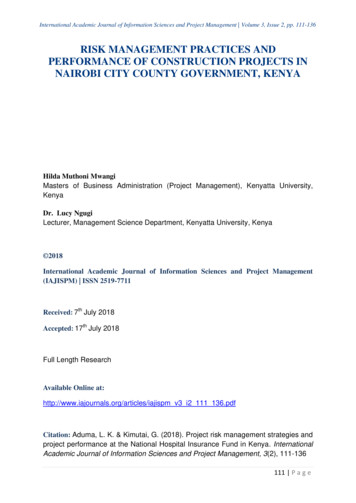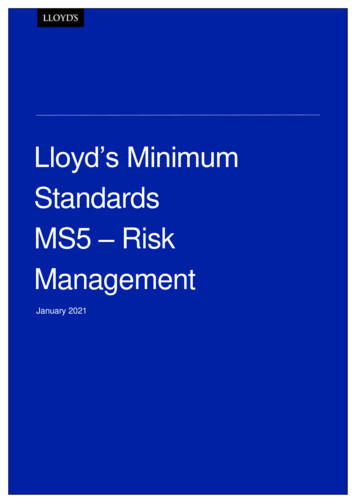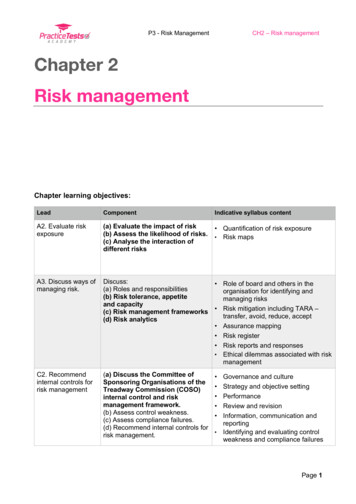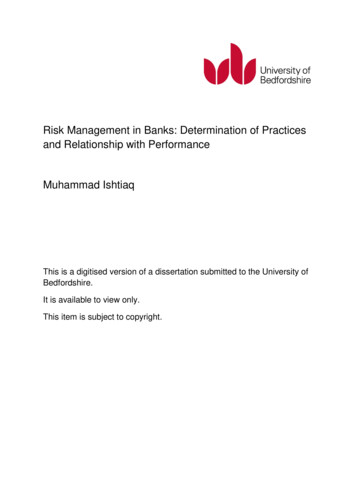
Transcription
International Academic Journal of Information Sciences and Project Management Volume 3, Issue 2, pp. 111-136RISK MANAGEMENT PRACTICES ANDPERFORMANCE OF CONSTRUCTION PROJECTS INNAIROBI CITY COUNTY GOVERNMENT, KENYAHilda Muthoni MwangiMasters of Business Administration (Project Management), Kenyatta University,KenyaDr. Lucy NgugiLecturer, Management Science Department, Kenyatta University, Kenya 2018International Academic Journal of Information Sciences and Project Management(IAJISPM) ISSN 2519-7711Received: 7th July 2018Accepted: 17th July 2018Full Length ResearchAvailable Online at:http://www.iajournals.org/articles/iajispm v3 i2 111 136.pdfCitation: Aduma, L. K. & Kimutai, G. (2018). Project risk management strategies andproject performance at the National Hospital Insurance Fund in Kenya. InternationalAcademic Journal of Information Sciences and Project Management, 3(2), 111-136111 P a g e
International Academic Journal of Information Sciences and Project Management Volume 3, Issue 2, pp. 111-136ABSTRACTRisks in construction projects cannot beeliminated, however through proper riskmanagement practices, the risks facing theconstruction projects can be minimized.Government funded projects are proclaimedto lag behind in their construction and tendto consume high costs of building andmaintenance due to various factors. Thestudy sought to establish the influence ofrisk management practices on performanceof projects by the Nairobi City CountyGovernment, Kenya. The specific objectiveswereto determine the effect of design riskmanagementpractices,legalriskmanagement practices, construction riskmanagement practices and contract riskmanagement practices on performance ofprojects. The performance of the Nairobicounty government funded constructionprojects was evaluated by ness and cost. The study was anchoredon the following theories; agency theory anduncertainty theory. Empirical literaturereviewed scholarly studies on design risk,legal risk, contract risk and construction riskmanagement practices and their influence onperformance of projects. The study used adescriptive research design. The populationof study involved contractors, consultantsand project engineers for 10 constructionprojects across the Nairobi City County.This consisted of 380 respondents involvedin projects from the companies. A sample of190 respondents was taken from thepopulation. The primary data was collectedby use of self-administered surveyquestionnaire. Data analysis was done byuse of descriptive and inferential statisticssuch as frequencies, percentages, meanscores and standard deviation. A regressionanalysis was conducted to establish thecorrelation between the variables. The studyrevealed that the most prevalent riskmanagement practices employed by theNairobi City County government onconstruction projects were costing ofprojects, project designing, and dispute overland and construction. The risk on risk and contract riskmanagement were found to have an inverserelationship with the construction projectperformance while design risk managementhad a positive one. The study recommendedthat for the construction department andconstructors to mitigate risks involved in theproject implementation process there is needfor proper project design, legal approval andpolicy requirements adherence, properplanning to ensure all resources are availableto effect the construction project and propercontracting with every stakeholder beingappreciated and involved in the projectplanning and formulation process.Key Words: project risk managementstrategies, project performance, NationalHospital Insurance Fund, KenyaINTRODUCTIONThe traditional project success has viewed narrowly as the achievement of intended outcomes interms of specification (quality), time and budget, Atkinson (2009). Dvir (2006) say this tends to112 P a g e
International Academic Journal of Information Sciences and Project Management Volume 3, Issue 2, pp. 111-136give the project manager an “operational mindset”. The definitions of project managementsuccess have since become more inclusive and emphasize the importance of working withstakeholders to define needs, expectations, and project tasks. Turner (2004) suggests that projectmanagers should be measured on a wider set of objectives and not just the achievement of time,cost and functionality goals. Project management success focuses upon project process and inparticular the successful accomplishment of cost, time and quality objectives. It also considersthe manner in which the management process was conducted. Project success deals with theeffects of the final product. There is need for the power sector project stakeholders to understandwhat constitutes project success in view of the many capital intensive projects they implement.Effective project implementation or simply put, project success can be measured on the basis oftime, cost and quality (performance), commonly known as the triple constraint. These threefactors represent the Key Performance Indicators (KPIs). To establish whether a project has beeneffectively implemented, or better still, if the project has been successful, one has to go back tothe initial project goals of time, cost and quality (performance) and be able to measure the extentof their individual achievement.The construction industry is vital to every country’s economy. The role and the importance of theindustry in the development of a country need not be over emphasized. The Kenyan constructionindustry contributes significantly in terms of scale and share in the development process of thecountry. According to the Kenya Bureau of Statistics, the construction industry contributed4.2%, 4.1%, 4.2%, and 4.4% towards the Gross Domestic Product (GDP) for the years 2010,2011, 2012 and 2013 respectively. This is apparent that the output from the construction industryis a major and integral part of the national output, accounting for a sizeable proportion in theGross Domestic Product (GDP) of the country. In Kenya the industry employed 100,100 peoplein 2010, 106,000 people in 2011, and 116,100 people in 2012 and 130,300 people in year 2013(Republic of Kenya, 2014).Despite the importance of the sector to the economy, it is beset by a number of challenges thatrequire introspection and understanding of the inherent risks management practices. In recentyears, poor performance of construction projects has provoked an increased interest into thenature and mechanism of risk management and analysis (Smith et al., 2006). They have observedthe industry as having a very poor reputation for coping with the adverse effects of change, withmany projects failing to meet deadlines and cost and quality targets. There are many riskmanagement practices factors that affect the construction industry. For instance, Mbeche andMwandali (2006) in their studies have established that project time and cost are greatly affected.70% of project initiated are found to have time overruns of over 50 % while 50 % of the projecthave cost escalation exceeding 20 percent. This is attributed to risk management factorsinfluencing the project objectives.Other empirical studies have documented a legion of causes ofdelay in performance of projects, some related to risk management practices.113 P a g e
International Academic Journal of Information Sciences and Project Management Volume 3, Issue 2, pp. 111-136Sambasivan and Soon (2007) identified causes of delays in the completion of constructionprojects, including contractor’s improper planning, poor site management, inadequateexperience, inconsistent flow of payments for completed work, poor management of subcontractors, inconsistent communication between parties, as well as shortage of materials,equipment, and labor. In South Africa, a government report linked infrastructural project delayswith changes in project design, inconsistent flow of financial resources, and contractor’s lack ofcapacity to deliver (Government of South Africa, 2009). In Ghana, delay in payments, poorcontractor management, delays in material procurement, poor technical performances, andescalation of material prices were identified as key factors accounting for about 80% of delays inthe completion of infrastructural projects (Frimpong, Olowoye, & Crawford, 2003).As evidenced from the critical review of the literature, projects are continuing to fail (Flyvbjerget al., 2003; Kutsch& Hall, 2005; Kutsch et al., 2011; Mulcahy, 2003; Raz et al., 2002; Sharmaet al., 2011; Standish Group, 2006, 2009) and complexity is increasing (Hillson& Simon, 2007;Philbin, 2008; Vidal et al., 2011). The literature questions the ability of general prescribedindustry risk management standards to effectively deal with complexity and irrationality (Smith& Irwin, 2006). Furthermore there is criticism in the literature of the ability of current generalprescribed industry risk management standards to effectively manage uncertainty and risk(Atkinson et al., 2006; Chapman & Ward, 2002, 2003b; De Meyer et al., 2002; Stoelsness& Bea,2005). Effectively managing uncertainty and risk in complex environment in particular appearsto be an important element towards enabling project success (Hillson& Simon, 2007; Raz et al.,2002; Zwikael&Ahn, 2011).The project management literature has been shown to contain concepts suggested as important toimproving the management of uncertainty and risk, particularly in complex projectenvironments. These concepts are referred to in this thesis to be ‘in advance’ of mainstreamstandards. They include explicit opportunity management (Hillson, 2002, 2004a; Olsson, 2007;Zhang, 2011), the uncertainty management paradigm (Chapman & Ward, 2003a, 2003b; Ward &Chapman, 2003), a constructively simple approach to the evaluation and interpretation ofestimates (Chapman et al., 2006), risk attitude (Hellier et al., 2001; Hillson& Murray-Webster,2005, 2008; Slovic, 1987; Smallman& Smith, 2003) and complexity theory concepts (CookeDavies et al., 2007). Critical of probabilistic risk management approaches in particular; otherresearchers have taken these further and suggested wider approaches as more appropriate in themanagement of uncertainty. Pender (2001) is critical of PMBoKs (2001) traditional use ofprobability theory. He indicates that probability-based risk management theory does not explainthe important aspects of observed project management practice.Construction risk management practices have been mostly found to exhibit dynamism andcontinuity across a project’s life cycle (Chan et al., 2009; Nieto-Morote&Ruz-Vila, 2010). Mark,Cohen and Glen (2004) have defined a risk management practice as potential for complicationsand problems with respect to the completion of a project and the achievement of a project goal.In addition, the impact or consequences of this future event must be unexpected or unplanned114 P a g e
International Academic Journal of Information Sciences and Project Management Volume 3, Issue 2, pp. 111-136(Chia, 2006). Construction project risk management practices can be defined as an uncertainevent or condition that, if it occurs, has a negative effect on at least one project objective, such astime, cost, or quality (Jomaah, Bafail, &Abdulaal, 2010). Unmanaged risks are therefore threatsto project delivery. Failure to adequately deal with risks has been shown to cause cost and timeoverruns in construction projects (Andi, 2006). Trying to eliminate all risks in constructionprojects is impossible. However, it is well accepted that a risk can be effectively managed tomitigate its’ adverse impacts on project objectives, even if it is inevitable in all projectundertakings.Project PerformanceManaging risks involves: planning, identifying, analyzing, developing risk handling strategies,monitoring and control. Project team members particularly clients, consultants and contractorsshould eliminate / mitigate delays when playing their respective roles. Risk managementpractices in construction projects are associated with contexts of the projects as well as personnelinvolved. According to Kishk and Ukaga (2008) the performance of any project is judged by thesatisfaction of stakeholders’ needs and is measured by the extent of meeting standards laid downat the start of the project. This is in regard to delivery of construction projects by contractorswithin budget, time, quality, environment, safety and performance. Construction projects areconsidered successful when delivered within scheduled duration, allocated budget, and specifiedquality (Majid, 2006; Owolabi et al., 2014). Delay in the completion of construction facilities isa critical challenge with a global dimension, often leading to increased costs due to timeextension or acceleration as well as loss of productivity, disruption of work, loss of revenuethrough lawsuits between contractual parties, and project abandonment (Sambasivan& Soon,2007; Owolabi et al., 2014).Many SSA economies experience losses amounting to billions of dollars, as a result of delayedcompletion of infrastructural projects, which undermines the noble goal of poverty reduction(Gutman et al., 2015). Delay in the completion of infrastructural projects has significant costimplications, which in turn bears far-reaching consequences in the lives of citizens, especially indeveloping countries like Kenya. Studies conducted in various contexts have deduced thatalthough delay in the completion of construction projects is a global phenomenon, it appears tobe more common in developing than in developed countries (Sambasivan& Soon, 2007;Alaghbari et al., 2007; Aziz, 2013). Among the developed countries, delay in the completion ofinfrastructural projects has been reported in Canada, the United States, Australia, and Britain,among others.In Canada for instance, De Souza (2009) attributed delays in the completion of infrastructuralprojects to various factors, including reduced funding by sponsors, communication breakdown,delayed disbursement of funds, poor site management by contractors, and tedious legislativeprocedures. In the United States, SNL Financial (2010) reported delay in the completion of apipeline project connecting Florida State and Bahamas, particularly due to design changes. In115 P a g e
International Academic Journal of Information Sciences and Project Management Volume 3, Issue 2, pp. 111-136Kenya, delays in the completion of infrastructural facilities have been associated with factors,such as poor financial management by government agencies, inadequate designs, and poormanagement of the construction process by contractors (Talukhaba, 2009). Arguably, thesefactors are compounded by secondary factors, such as poor management of materials andequipment by contractors, inadequate recognition and response to risks emanating from thephysical and socio-economic environments, as well as inadequate regard for stakeholders’ needs(Talukhaba, 2009). Another study conducted by Ondari and Gekara (2013) reported significantcorrelation between project delays and factors, such as management support, designspecifications, contractor’s capacity, and supervision capacity. This study will assess if riskshave a significant influence on the completion of public projects by the Nairobi City CountyGovernment, Kenya.The Nairobi City County is one of the 47 devolved units in Kenya whose capital is the country’scapital city. The Nairobi City County is the creation of the Constitution of Kenya 2010 andsuccessor of the defunct City Council of Nairobi. It operates under the auspices of the Cities andUrban Areas Act, The Devolved Governments Act and a host of other Acts. The Nairobi CityCounty is charged with the responsibility of providing a variety of services to residents within itsarea of jurisdiction. These include the services that were hitherto provided by the defunct CityCouncil and the ones that have been transferred from the national government. The formerinclude Physical Planning, Public Health, Social Services and Housing, Primary EducationInfrastructure, Inspectorate Services, Public Works, Environment Management while the latterinclude Agriculture, Livestock Development and Fisheries, Trade, Industrialization, CorporateDevelopment, Tourism and Wildlife, Public Service Management.Risk Management PracticesRisk Management of the activities in a proposed baseline is evaluated to determine their potentialfor risk towards a construction project. This evaluation assesses all activities against a set ofscreening categories typically in the areas of construction, interface control, safety, regulatoryand environmental, security, design, resources and space migration. There are diverse causes andmanifestations of risks in projects. Wanyona (2005) attributes risks related to project finance tothe ineffective cost planning and control of building projects by the cost consultants. Because ofthe complex nature of construction projects, this approach has resulted to delays, litigation andeven bankruptcy. Kishk and Ukaga (2008) note that the degree of risk management processundertaken during the project lifecycle impacts directly on the project success. Failure to manageconstruction risks in a systematic way makes the project suffer in cost overruns, delayedcompletion, non-completion or may fail to meet the quality specifications and the benefits theywere intended for.Management of construction projects involves a great deal of managing risks. Managing risksinvolves: planning, identifying, analyzing, developing risk handling strategies, monitoring andcontrol. Project team members particularly clients, consultants and contractors should eliminate /116 P a g e
International Academic Journal of Information Sciences and Project Management Volume 3, Issue 2, pp. 111-136mitigate delays when playing their respective roles. Cohen and Palmer (2004) identify sources ofconstruction risks to include changes in project scope and requirements; design errors andomissions; inadequately defined roles and responsibilities; insufficient skilled staff; forcemajeure; and new technology. Baloi and Price (2003) categorize construction risks as technical,social, construction, economic, legal, financial, natural, commercial, logistics, and political.Similarly, Mills (2001) lists three most important risks to include: weather, productivity oflabour and plant and quality of material. Other researchers such as Finnerty (2006), and Millerand Lessard (2001) have categorized same risks in addition to demand, supply, regulatory,operational, completion and sovereign.Risk management practices in construction projects are associated with contexts of the projectsas well as personnel involved. Al-Kharashi and Skitmore (2008) point out that the main cause ofdelay in construction sector for public projects is the lack of qualified and experienced personnel.A study by Ahmed, Azhar, Castillo and Kappagantula, (2002) identified ten most critical causesas building permits approval, change order, changes in drawings, incomplete documents,inspections, changes in specifications, decision during development stage and shop drawings andapproval. Sambasivan and Soon (2007) identify ten most important causes of risks in theconstruction industry to be contractor’s improper planning, contractor’s poor site management,inadequate contractor experience, inadequate client’s finance and payments for completed work,problems with subcontractors, shortage in material, labor supply, equipment availability andfailure, lack of communication between parties, and mistakes during the construction stage.Construction Projects in Nairobi City County Government, KenyaMany projects fail due to risk management practices in the implementation of the constructionprojects by the Nairobi’s county government. In 2009 there were many projects which finishedwith poor performance because of many evidential poor risk management, non-availability ofmaterials, road closure, amendment of the design and drawing which are entailed in projectsdesign risks, additional works, waiting the decision, handing over, variation order, amendmentsin Bill of Quantity (B.O.Q) and delay of receiving drawings (Strenman, 2012). Nonetheless thereare other factors for problems of performance in Kenya such as project management,coordination between participants, amongst other factors.Construction risks have been mostly found to exhibit dynamism and continuity across a project’slife cycle (Chan et al., 2009; Nieto-Morote & Ruz-Vila, 2010). Mark, Cohen and Glen (2004)have defined a risk as potential for complications and problems with respect to the completion ofa project and the achievement of a project goal. In addition, the impact or consequences of thisfuture event must be unexpected or unplanned (Chia, 22006). Construction project risks can bedefined as an uncertain event or condition that, if it occurs, has a negative effect on at least oneproject objective, such as time, cost, or quality (Jomaah, Bafail, & Abdulaal, 2010). Risks aretherefore threats to project delivery. Failure to adequately deal with risks has been shown tocause cost and time overruns in construction projects (Andi, 2006). Trying to eliminate all risks117 P a g e
International Academic Journal of Information Sciences and Project Management Volume 3, Issue 2, pp. 111-136in construction projects is impossible. However, it is well accepted that a risk can be effectivelymanaged to mitigate its’ adverse impacts on project objectives, even if it is inevitable in allproject undertakings. Sources of risks includes inherent uncertainties and issues relative tocompany’s fluctuating profit margin, competitive bidding process, weather change, job-siteproductivity, the political situations, inflation, contractual rights, and market competition (KarimiAzari et al., 2011). It is important for the construction companies to face these risks by assessingtheir effects on the project objectives. Risk management helps in deciding which of the project ismore risky, planning for the potential sources of risk in each project, and managing each sourceduring construction (Zayed, Amer, & Pan, 2008). It is important that risk is distinguished fromuncertainty. Smith, Merna, and Jobling, (2006) defines uncertainty as a chance of occurrence ofsome event where the probability and distribution is not known. They distinguish uncertaintyfrom risk as being where the outcome of an event or a set of outcomes can be predicted on thebasis of statistical probability. This implies that there is some knowledge about a risk as opposedto an uncertainty about which there is no knowledge.STATEMENT OF THE PROBLEMPerformance of projects fails due to poor implementation of risk management practices in place.There are a number of well-established techniques and tools used for managing project risks inlarge organizations (White and Fortune, 2002); there has been little research publications on thetools and techniques used in managing project risks in small projects and performance (Bryde,2003).It has been observed and decried by the public and other users of Government fundedprojects that they always lag behind in time, which conversely have a bearing on cost, due tovarious factors. Among such, as observed by Waihenya (2011), Seboru (2006), Kivaa (2000),Talukhaba (2009), Mbatha (2006) and Baradyana (2006) are variation in cost of buildingmaterials, changes in design of building, changes in finishes by client, contractor running out ofmoney to run projects for some time, hiring extra tools during construction not anticipated,under-estimation of cost of construction by the project Quantity Surveyor, application of wrongtime estimation model and increment weather patterns, among many others. Most of the existingstudies based on risk management practices and performance of public projects point at thecontractor as the sole contributor to delays and project failure and ignore the complexity of risksin the entire phase of project implementation such as Waihenya (2011), Seboru (2006), Kimani(2004), Kivaa (2000), Talukhaba (2009), Mbatha (2006) and Baradyana (2006). According to theNairobi City County Government (2017), most construction projects in the city by delegatedcontractors are always facing challenges of delays, budget overruns, change of designs due todisputes over invasion of human settlements to the road reserves and illegal construction ofbuildings on public land, public utilities and along power lines. This had made construction ofroads, government buildings, water and sewage systems and power lines expensive and takingmore time than planned. This study sought therefore to fill this research gap by investigating thetotality of the causes and effects of project design risks, legal risks, construction risks and118 P a g e
International Academic Journal of Information Sciences and Project Management Volume 3, Issue 2, pp. 111-136contract management risks on performance of construction projects by the Nairobi City CountyGovernment, Kenya.GENERAL OBJECTIVEThe general objective of the study was to investigate the influence of risks management practiceson the performance of construction projects in KenyaSPECIFIC OBJECTIVES1. To establish the influence of Design Risk on the performance of construction projects bythe Nairobi City County Government, Kenya.2. To determine the influence of Legal Risk towards the performance of constructionprojects by the Nairobi City County Government, Kenya.3. To find out the influence of construction Risk on the performance of constructionprojects by the Nairobi City County Government, Kenya.4. To assess the influence of contract management Risk on the performance of constructionprojects by the Nairobi City County Government, Kenya.THEORETICAL LITERATUREAgency TheoryThis theory was proposed by Smith &Stulz (1985). The Agency theory extends the analysis ofthe firm to include separation of ownership and control, and managerial motivation. In the fieldof corporate risk management agency issues have been shown to influence managerial attitudestoward risk taking and hedging. Theory also explains a possible mismatch of interest betweenshareholders, management and debt holders due to asymmetries in earning distribution, whichcan result in the firm taking too much risk or not engaging in positive net value projects(Mayers& Smith, 2012). Consequently, agency theory implies that defined hedging policies canhave important influence on firm value (Fite&Pfleiderer, 1995). The latter hypotheses areassociated with financing structure, and give predictions similar to financial theory.Managerial motivation factors in implementation of corporate risk management have beenempirically investigated in a few studies with a negative effect (Faff & Nguyen, 2012). In theabsence of the traditional equity-owner, responsible for assuming the residual risk and guaranteeof debt repayment, project-financing arrangements are often accompanied by detailed andcomplex contracts which specify the exact nature and duration of the relationships betweenvarious participants in the project. It becomes necessary to carefully identify the risks that mayoccur over the life of the project, from conception to operation, and allocate those risks to theparticipants who are best able to manage them (Zou, Zhang & Wang, 2013)To manage various types of risk the project sponsor or financial advisor may develop a matrix ofproject participants and risk components associated with the project to identify risk allocation119 P a g e
International Academic Journal of Information Sciences and Project Management Volume 3, Issue 2, pp. 111-136and the various contractual agreements which allocate risk (Minato (2012) agency risk may bereduced or eliminated by the competition between project managers in managerial labourmarkets (Hamimah, 2010). As project size increases, the two functions usually attributed to theproject manager; management and risk bearing, may be treated as naturally separate factors ofproduction within a set of contracts known as the project managed by the project managementteam. Although individual project stake-holders act from self interest, they realize that their ownindividual destinies depend, to some extent, on the success of the project management team in itscompetition with other project management teams. As the number of project stakeholdersincreases, the potential agency incentive problems, associated with the separation of ownershipand control of the project, would tend to be resolved by the discipline exerted on projectmanagers by managerial labour markets both within and outside the project (Akintoye &MacLeod, 2012).The theory links that principal who is the county government of Nairobi and the agent who arethe implementers of the construction projects in the County. The principal assumes that the agentacts in the best interest of the success of the project and beneficiaries. This overlooks the interestof the agent who may compromise on the quality for profitability.Uncertainty TheoryUncertain theory was introduced by Liu (2010) due to generalization of domain of uncertainty.Uncertainty theory was also applied to uncertain logic by Li and Liu (2010) in which the truthvalue is defined as the uncertain measure that the proposition is true. Furthermore, uncertainentailment was proposed by Liu that is a methodology for calculating the truth value of anuncertain formula when the truth values of other uncertain formulas are given. Uncertainty is, ofcourse, not a neglected concept in project management. Early development of activity networktechniques in the 1950s, such as PERT (Program Evaluation and Review Technique), recognizedthe possibility of variation in task durations. These techniques were extended in the 1960s toincorporate probabilistic branching for instance Graphical Evaluatio
the important aspects of observed project management practice. Construction risk management practices have been mostly found to exhibit dynamism and continuity across a project's life cycle (Chan et al., 2009; Nieto-Morote&Ruz-Vila, 2010). Mark, Cohen and Glen (2004) have defined a risk management practice as potential for complications











